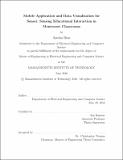| dc.contributor.advisor | Sep Kamvar. | en_US |
| dc.contributor.author | Bose, Ayesha (Ayesha P.) | en_US |
| dc.contributor.other | Massachusetts Institute of Technology. Department of Electrical Engineering and Computer Science. | en_US |
| dc.date.accessioned | 2016-12-22T15:15:43Z | |
| dc.date.available | 2016-12-22T15:15:43Z | |
| dc.date.copyright | 2016 | en_US |
| dc.date.issued | 2016 | en_US |
| dc.identifier.uri | http://hdl.handle.net/1721.1/105940 | |
| dc.description | Thesis: M. Eng., Massachusetts Institute of Technology, Department of Electrical Engineering and Computer Science, 2016. | en_US |
| dc.description | This electronic version was submitted by the student author. The certified thesis is available in the Institute Archives and Special Collections. | en_US |
| dc.description | Cataloged from student-submitted PDF version of thesis. | en_US |
| dc.description | Includes bibliographical references (pages 67-70). | en_US |
| dc.description.abstract | Understanding early childhood development can help teachers individualize their methods to facilitate growth in children. The Montessori educational approach emphasizes independence and allows children to guide their own learning. Given this style of learning, a crucial part of this kind of education is observation of the students, so teachers can assist individuals and help address specific developmental needs. Sensei aims to assist this observation through a dynamic range-based sensor network that detects proximity. These sensors are placed on the children's shoes, on lessons, and around the classroom. I developed the mobile application and the visualization dashboard for the Sensei system. Teachers can maintain the sensor deployment in their classroom through a mobile application. This allows teachers to start the sensors in their classroom at the beginning of each day. They can also collect data from the sensors at the end of the day and view an initial graph of the collected data, showing the time they spent with each child. With this unique data set, we also provide detailed visualizations to teachers so they can determine who children are spending their time with, what lessons they are spending time with, and what areas of their classroom are most active. With this data, teachers can, for example, determine the right time to introduce a child to a new lesson or re-arrange their classroom to facilitate learning. These visualizations are easily accessible for teachers in a web application. Sensei helps discover insights for teachers that would have otherwise been lost. This system can help provide a deeper understanding of early childhood development for teachers, educators, and researchers. | en_US |
| dc.description.statementofresponsibility | by Ayesha Bose. | en_US |
| dc.format.extent | 70 pages | en_US |
| dc.language.iso | eng | en_US |
| dc.publisher | Massachusetts Institute of Technology | en_US |
| dc.rights | M.I.T. theses are protected by copyright. They may be viewed from this source for any purpose, but reproduction or distribution in any format is prohibited without written permission. See provided URL for inquiries about permission. | en_US |
| dc.rights.uri | http://dspace.mit.edu/handle/1721.1/7582 | en_US |
| dc.subject | Electrical Engineering and Computer Science. | en_US |
| dc.title | Mobile application and data visualization for Sensei : sensing educational interaction in Montessori classrooms | en_US |
| dc.type | Thesis | en_US |
| dc.description.degree | M. Eng. | en_US |
| dc.contributor.department | Massachusetts Institute of Technology. Department of Electrical Engineering and Computer Science | |
| dc.identifier.oclc | 965197368 | en_US |
